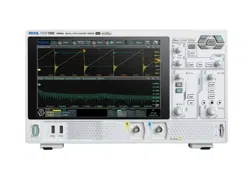Loading ...
Loading ...
Loading ...

Only when you select the channel that has signal inputs as the trigger source, can you
obtain a stable trigger.
Signal Type
Click or tap the drop-down button of Signal Type to select the desired signal type.
• CAN_H: indicates the actual CAN_H bus signal.
• CAN_L: indicates the actual CAN_L bus signal.
• TX/RX: indicates the Transmit signal and Receive signal from the CAN bus
transceiver.
• DIFF: indicates the CAN differential bus signals connected to an analog channel
by using a differential probe. Connect the probe's positive lead to the CAN_H
bus signal and connect the negative lead to the CAN_L bus signal.
Baud Rate
Click or tap the drop-down button of Baud to select the preset baud rate. The
available baud rates include 10 kbps, 20 kbps, 33.3 kbps, 50 kbps, 62.5 kbps, 83.3
kbps, and etc. You can also self-define the baud rate.
Sample Position
Sample position is a point within a bit's time. The oscilloscope samples the bit level at
this point. The sample position is represented by the proportion of "the time from the
start of the bit to the sample position" to the "bit time", as shown in the figure below.
One Bit
60%
70%
80%
Figure 8.34 Sample Position
Click or tap the input field of
Sample Position to set it by using the pop-up numeric
keypad. You can also use the corresponding multipurpose knob to set the value. The
settable range is from 10% to 90%.
Trigger Condition
Click or tap the drop-down button of When to select the desired trigger condition.
• SOF: triggers at the start of a frame.
• EOF: triggers at the end of a frame.
Triggering the Oscilloscope
DHO1000 User Guide
110
Copyright ©RIGOL TECHNOLOGIES CO., LTD. All rights reserved.
Loading ...
Loading ...
Loading ...
